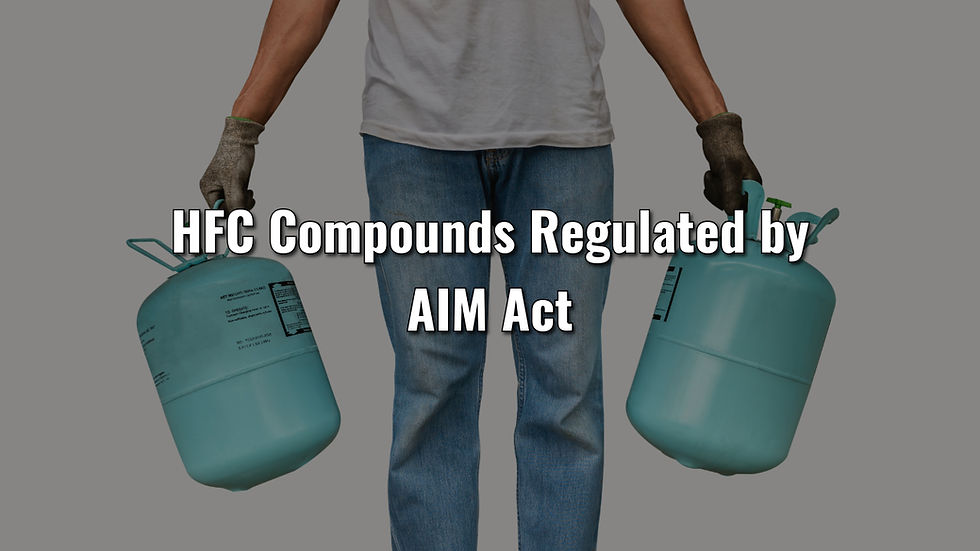TFA and the Future of Refrigerants: Persistence, Toxicity, and Solutions
- donaldarrington
- Apr 17
- 2 min read
Updated: Apr 22
What is Trifluoroacetic acid (TFA)?

Trifluoroacetic acid (TFA) is a short chain perfluorinated carboxylic acid (PFCA) that is environmentally persistent. TFA is particularly important because many longer-chain PFASs degrade into this compound. While TFA is produced through multiple anthropogenic pathways, including industrial synthesis and wastewater discharge, a significant source is the atmospheric degradation of fluorocarbon-based refrigerants.
With the ongoing phaseout of legacy refrigerants such as hydrofluorocarbons (HFCs), the industry is shifting toward hydrofluoroolefins (HFOs), which are considered more climate-friendly due to their significantly shorter atmospheric lifetimes and lower global warming potentials. However, concerns are emerging around their environmental byproducts. Specifically, HFOs have been shown to degrade more readily in the lower atmosphere, leading to a higher fraction of trifluoroacetic acid (TFA) being formed near the point of emission, where it can more directly impact local ecosystems and water sources.
![Figure 1. Yields of TFA from selected individual chlorofluorocarbon (CFC) replacement compounds, and their estimated global emissions [1]](https://static.wixstatic.com/media/77e8f1_9fb53ff71a9d4875891b52494ae3e94e~mv2.png/v1/fill/w_624,h_500,al_c,q_85,enc_avif,quality_auto/77e8f1_9fb53ff71a9d4875891b52494ae3e94e~mv2.png)
Toxicity and Ecotoxicological Considerations
Despite its persistence, the toxicity of TFA appears to be relatively low. The study [2] summarizes toxicity studies across various organisms—from aquatic algae and plants to terrestrial crops and mammals. Most toxicological endpoints indicate that TFA’s concentrations, even when rising due to increased HFO use, are unlikely to cause significant adverse effects in aquatic environments or in humans because they are rapidly excreted. However, the potential for bioaccumulation in certain terrestrial plants is noted and warrants further investigation, especially if atmospheric and aquatic TFA levels continue to increase.
Path Forward and Our Goal
Recently, NIST published the Refrigerant Properties Development R&D: Final Report, highlighting the industry's need to pursue refrigerant solutions that not only meet performance and safety standards but also reduce environmental byproducts like TFA. In response, scientists and industry leaders are increasingly focused on designing next-generation refrigerants and blends that minimize or eliminate TFA formation altogether.
At Yuji, we recognize that sustainability and innovation must go hand in hand. Our R&D team has already developed several promising chemical candidates with low global warming potential (GWP), zero ozone depletion potential (ODP), and no TFA generation. These advanced compounds are being tailored for diverse applications and are scheduled for commercialization within the next three years.
We believe collaboration is key to accelerating this transition. Whether you're a manufacturer, researcher, or policymaker, we welcome the opportunity to work together toward a cleaner, more responsible future for refrigerants. Let’s drive innovation that not only meets today's performance demands but also safeguards tomorrow’s environment.
Reference:
1. Madronich, S., Sulzberger, B., Longstreth, J. D., Schikowski, T., Andersen, M. S., Solomon, K. R., & Wilson, S. R. (2023). Changes in tropospheric air quality related to the protection of stratospheric ozone in a changing climate. Photochemical & Photobiological Sciences, 22(5), 1129-1176.
2. Garavagno, M. D. L. A., Holland, R., Khan, M. A. H., Orr-Ewing, A. J., & Shallcross, D. E. (2024). Trifluoroacetic acid: toxicity, sources, sinks and future prospects. Sustainability, 16(6), 2382.
3. McLinden, M., Avery, K., Bazyleva, A., Bell, I., Fortin, T., Huber, M., ... & Rowane, A. (2025). Refrigerant Properties Development R&D: Final Report to US Department of Energy on Interagency Agreements 892434-19-S-EE000031 and 892434-23-S-EE000120.




Comments